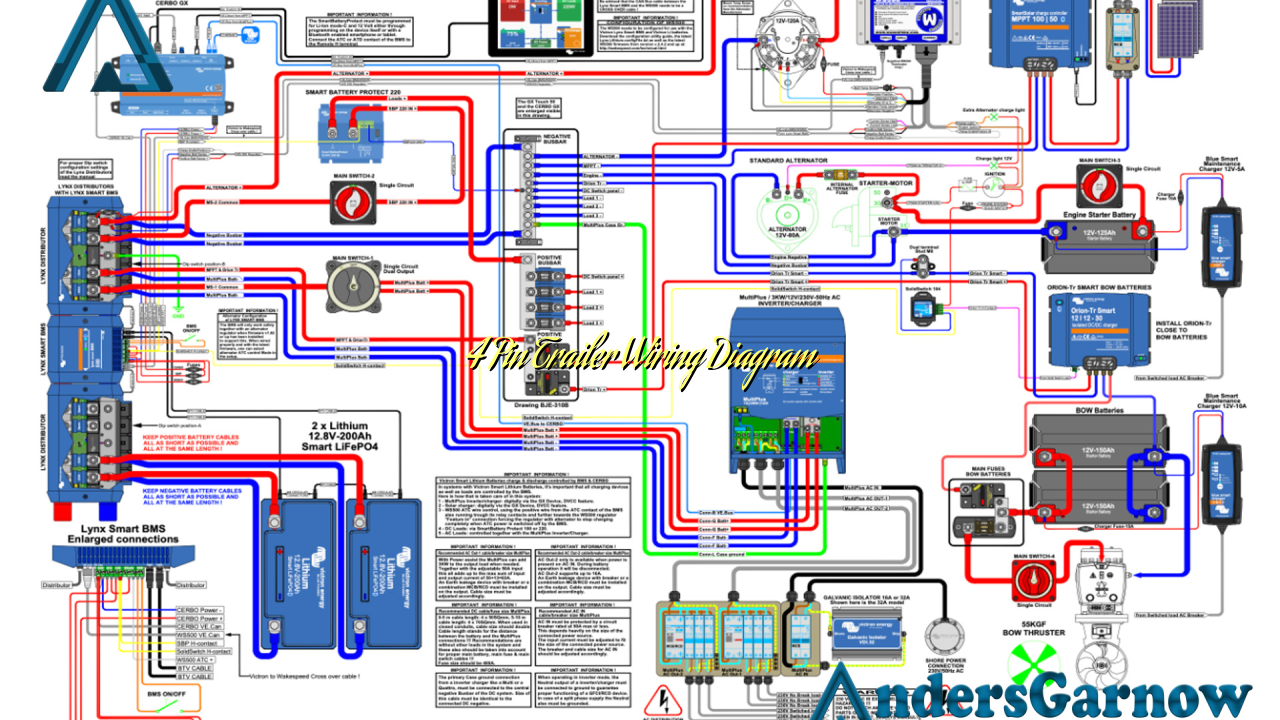Hello readers! Today, we will be discussing the 4 pin trailer wiring diagram. This diagram is essential for those who are looking to connect their trailers to their vehicles safely and efficiently. Understanding the wiring diagram will aid in proper installation and troubleshooting. So, let’s dive in and explore this topic further!
1. The Basics of 4 Pin Trailer Wiring
Before we delve into the details, let’s first understand the basics of 4 pin trailer wiring. This type of wiring is commonly used for small trailers, such as utility trailers, boat trailers, or camper trailers. It consists of four wires that are color-coded for easy identification.
The four wires in a 4 pin trailer wiring system are:
| Wire Color | Function |
|---|---|
| White | Ground |
| Brown | Taillights |
| Yellow | Left Turn and Brake Lights |
| Green | Right Turn and Brake Lights |
These wires are responsible for transmitting power and signals from the vehicle to the trailer lights, allowing proper functionality and safety while towing.
2. Installation Process
Now that we understand the basics, let’s discuss the installation process of a 4 pin trailer wiring system. It is important to follow these steps carefully to ensure a successful installation:
- Start by locating the vehicle’s trailer wiring connector. This is usually found near the rear bumper.
- If the vehicle does not have a pre-installed connector, you may need to install one. Consult the vehicle’s manual or seek professional help for this step.
- Once the connector is in place, identify the corresponding wires on both the vehicle and the trailer.
- Connect the white wire to the vehicle’s ground wire. This is usually done by attaching it to a metal part of the vehicle’s frame.
- Connect the brown wire to the taillights of the trailer.
- Connect the yellow wire to the left turn and brake lights of the trailer.
- Connect the green wire to the right turn and brake lights of the trailer.
- Secure all connections with electrical tape or heat shrink tubing to prevent any loose connections.
- Test the trailer lights to ensure they are functioning properly.
- If everything is working correctly, tidy up the wiring and secure it to prevent any damage during towing.
Following these steps will help you install a 4 pin trailer wiring system correctly and ensure a safe towing experience.
3. Advantages of 4 Pin Trailer Wiring
There are several advantages to using a 4 pin trailer wiring system:
- Simplicity: The 4 pin setup is relatively simple and easy to understand for both beginners and experienced individuals.
- Compatibility: Most small trailers are designed to work with a 4 pin wiring system, making it a widely compatible option.
- Cost-effective: Compared to other wiring systems, the 4 pin setup is often more affordable, making it a popular choice among trailer owners.
- Ease of troubleshooting: With only four wires, it is easier to identify and troubleshoot any potential issues that may arise during towing.
These advantages make the 4 pin trailer wiring system a practical and efficient choice for many trailer owners.
4. Alternatives to 4 Pin Trailer Wiring
While the 4 pin trailer wiring system is widely used, there are alternative wiring setups available depending on the specific requirements of your trailer. Some common alternatives include:
- 5 Pin Wiring: This setup includes an additional wire for the surge brakes, commonly found in larger trailers.
- 6 Pin Wiring: Similar to the 5 pin setup, the 6 pin wiring system includes an additional wire for the 12V charging circuit.
- 7 Pin Wiring: This wiring system is commonly used for larger trailers and RVs. It includes additional wires for the reverse lights and auxiliary power.
It is important to determine the specific needs of your trailer and choose the appropriate wiring setup accordingly.
Conclusion
In conclusion, understanding the 4 pin trailer wiring diagram is essential for safe and efficient towing. This diagram provides a clear guide on how to connect the wires from the vehicle to the trailer, ensuring proper functionality of the lights. Remember to follow the installation process carefully and consider alternative wiring setups if needed. By doing so, you can enjoy a hassle-free towing experience and ensure the safety of yourself and others on the road.
Frequently Asked Questions (FAQ)
Q: Can I use a 4 pin wiring system for a larger trailer?
A: No, a 4 pin wiring system is not suitable for larger trailers. It is designed for small trailers that do not require additional features like surge brakes or auxiliary power.
Q: How do I troubleshoot issues with my 4 pin trailer wiring?
A: Start by checking the connections for any loose wires or corrosion. Ensure that the wires are properly connected to their corresponding functions. Using a multimeter, test for continuity and voltage in each wire to identify any potential issues.
Q: Can I install a 4 pin trailer wiring system by myself?
A: Yes, installing a 4 pin trailer wiring system can be done by yourself if you have basic knowledge of electrical connections. However, if you are unsure or uncomfortable with the process, it is recommended to seek professional help to avoid any mistakes or safety hazards.

